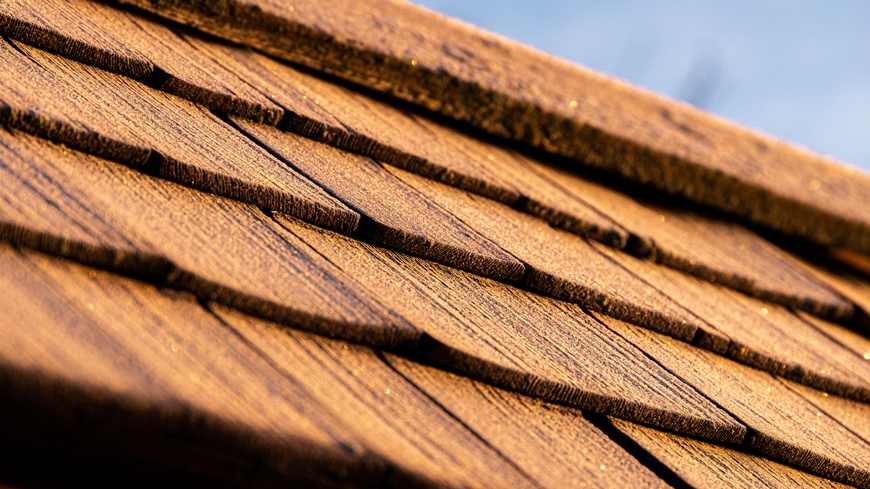Innovative wood-based materials
Alpine inspiration
Traditional shingle production has inspired researchers at Empa and ETH Zurich to develop new types of wood-based panels made from split wooden sticks. Thanks to an AI-optimized process, these panels should be suitable for load-bearing components in the future – even if produced from lower-quality wood and tree trunks.

Wooden shingles characterize the appearance of roofs and facades in the Alpine region – and have been hand-crafted for generations. This centuries-old craft inspired researchers at Empa and ETH Zurich to use this very efficient wood separation method to produce new types of wood-based materials. “In view of the growing impact of climate change on our forests and the construction sector, the production of panels from split sticks is an obvious choice. This means that they can be produced from wood of varying quality and from hardwood species, generate less material loss and should come close to solid wood products in terms of strength,” says Ingo Burgert, Professor at ETH Zurich and leader of a research team at Empa.
In Central Europe, spruce in particular is coming under increasing pressure due to longer periods of drought. More drought-resistant deciduous tree species will therefore play a more important role in the future. At the same time, the majority of hardwood in this country is currently burned to generate energy – despite the fact that more and more buildings are being built with wood, not least because as a renewable resource it binds CO2 in the building material for longer periods.
Splitting for maximum material yield

Traditionally, shingles are split by hand from log segments, while industrial processes rely on pneumatic splitting tools. “Shingle production shows us how wood can be processed in an energy-efficient and material-efficient way,” explains Burgert. “Wood can be split parallel to the fibers with minimal energy and almost no losses.” This chipless wood processing considerably increases the sawn timber yield, which, at around 60%, is significantly lower in Swiss sawmills.

In traditional shingle production, however, only selected high-quality softwood is usually used. In order to adapt the process for lower-quality hardwood species and to split longer sticks, the researchers rely on a two-stage splitting process. First, flat elements are separated, which are then further processed into wooden sticks of the desired dimensions. On a laboratory scale, the researchers adapted an apparatus for splitting firewood for this purpose. Thanks to a multi-bladed splitting head, several boards or sticks can be produced at the same time during one splitting process.
Selection thanks to AI

The splitting process produces wooden sticks in the direction of the grain without cutting the stiff and strong fibers. However, the irregular shape of the sticks poses a challenge. To overcome this, Burgert and his team are relying on artificial intelligence (AI). An automated camera system captures high-resolution images of each wooden bar, which are fed into a neural network. “With AI, we can determine important wood properties such as stiffness for each stick, regardless of shape, size or type of wood,” explains Empa researcher Mark Schubert. “If we use different types of wood of different qualities in the future, wood sorting will play a crucial role. With our machine learning algorithms, we therefore generate as much data as possible about each individual piece of wood in order to use it optimally for wood-based materials with defined properties.”
The team has pressed the first panels without sorting the wooden sticks beforehand. Even so, the potential of the manufactured demonstrators is already apparent: The panels can be produced in a highly resource-efficient manner and have mechanical properties that make them ideal for load-bearing components in the future. Despite challenges in terms of production processes, bonding, scalability and the predictability of material properties, Burgert is optimistic: “Our process has the potential to offer a sustainable alternative for the use of wood in times of accelerating climate change.”
New center for wood research in the planning
The project Split wood rods for innovative wood-based panels in construction is part of the Mainstreaming Wood Construction (MainWood) initiative. This initiative, which is supported by the ETH Board, promotes the increased use of wood in the construction industry. In addition, a Center for Wood Materials and Structures is currently being planned, which will bundle wood research at Empa and ETH Zurich and increase its visibility. As a central point of contact, the center will initiate innovative projects together with the wood industry in order to make better use of wood along the entire value chain. By developing new types of wood-based materials and technologies, the diverse application possibilities of the renewable and CO₂-storing resource wood are to be made even more accessible.
Prof. Dr. Ingo Burgert
Cellulose & Wood Materials
Phone +41 58 765 4434
Dr. Mark Schubert
Cellulose & Wood Materials
Phone +41 58 765 7624
Green technology
Wood is the raw material of the future. It is abundant in Switzerland, is renewable and binds carbon dioxide as it grows. And it is much more versatile than you might think. Empa researchers make wood glow or produce “green electronics” from cellulose fibers, for example environmental sensors or even batteries. They are also analyzing and optimizing the use of wood in Switzerland so that we can use this natural material as sustainably and climate-effectively as possible in the future.
Read the latest EmpaQuarterly online or download the PDF version.
-
Share






